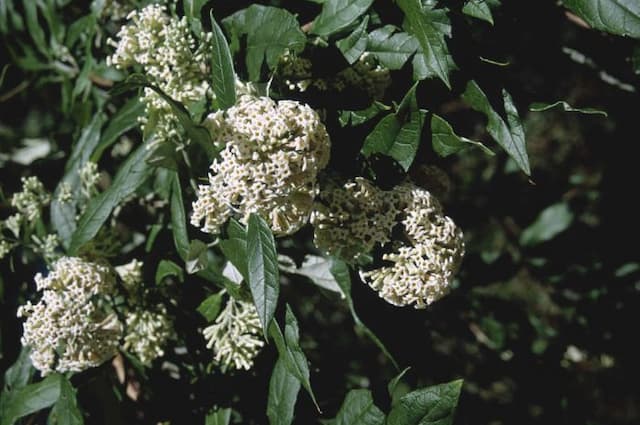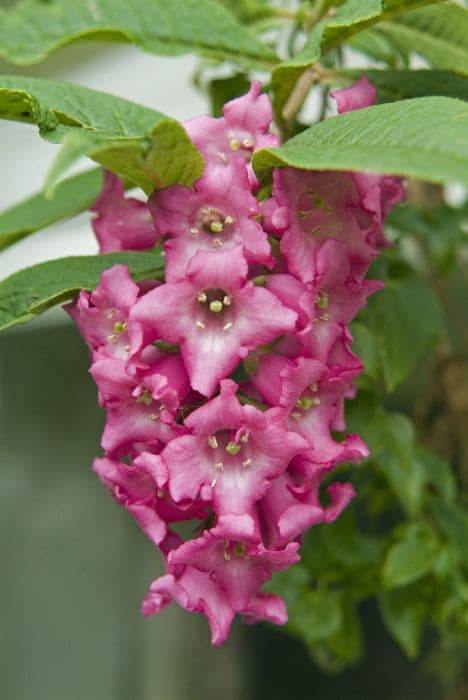Butterfly Bush Buddleja Sugar Plum = 'Lonplum' (PBR)
![butterfly bush [Sugar Plum]](/_next/image?url=https%3A%2F%2Fplants-admin.emdemapps.com%2Fimages%2Fplants%2F%2Fimages%2F604b59ea92b84.png&w=3840&q=75)
ABOUT
Buddleja Sugar Plum, also known as Butterfly Bush, boasts a striking appearance with its rich foliage and colorful blossoms. The leaves of this plant are elongated and exhibit a lush green color that provides a dense backdrop for its flowers. As the plant matures, it produces eye-catching blooms that have a distinctively plump and conical shape, gathering into clusters that project an impressive display of floral beauty. The flowers of the Butterfly Bush are particularly notable for their vibrant hues, blending deep purples and pinks in a gradient that can excite any onlooker's senses. As they bloom, the multi-toned purple flowers exude a delightful fragrance, which not only adds to the sensory allure of the plant but also serves to attract various pollinators such as butterflies and bees, hence the common name. This characteristic makes the Buddleja Sugar Plum a favorite among gardeners who aim to create lively and dynamic gardens that support local ecosystems. The overall appearance of the plant is both whimsical and structured, with its blooms forming a distinctive, almost fluffy appearance that stands out amongst other garden plantings. It is the combination of its colorful, sweet-smelling blooms and its robust green foliage that makes the Butterfly Bush a standout selection for any garden looking to add a splash of color and a touch of wild beauty.
About this plant
 Names
NamesSynonyms
Butterfly Bush, Summer Lilac
Common names
Buddleja 'Lonplum'.
 Toxicity
ToxicityTo humans
The Butterfly Bush, as Buddleja Sugar Plum is commonly known, is generally not considered toxic to humans. There are no well-documented reports of poisoning from this plant upon ingestion. However, it's always wise to be cautious and avoid eating any part of ornamental plants as they are not intended for human consumption.
To pets
The Butterfly Bush is also not known to be toxic to pets. There is limited information on its effects if ingested by animals, but it is not typically listed as a plant that is poisonous to pets like dogs and cats. However, it's always a good practice to prevent pets from chewing on non-food plants to avoid any potential gastrointestinal upset.
 Characteristics
CharacteristicsLife cycle
Perennials
Foliage type
Deciduous
Color of leaves
Green
Flower color
Purple
Height
5 feet (1.52 meters)
Spread
4 feet (1.22 meters)
Plant type
Shrub
Hardiness zones
6
Native area
China
Benefits
 General Benefits
General Benefits- Attracts Wildlife: The Buddleja Sugar Plum is known for attracting butterflies, bees, and other pollinators to the garden.
- Low Maintenance: Requires minimal pruning and care once established, making it ideal for those looking for easy-to-maintain plants.
- Drought Tolerance: Once established, it has good tolerance to periods of drought, reducing the need for frequent watering.
- Fast Growth: It grows quickly, which makes it a good choice for gardeners looking to achieve a mature look in a shorter period of time.
- Long Flowering Season: Offers a long blooming season, typically from summer into autumn, providing extended interest in the garden.
- Fragrance: The flowers emit a pleasant fragrance that can add a sensory dimension to garden spaces.
- Compact Size: Its compact growth habit makes it suitable for smaller gardens or for growing in containers on patios or balconies.
- Ornamental Appeal: Features striking deep purple flowers that add a splash of color and aesthetic appeal to garden beds and borders.
- Hardiness: It is relatively hardy in a range of climates, making it a versatile choice for many gardeners.
- Easy Propagation: Can be easily propagated from cuttings, which allows gardeners to create more plants for their garden or to share with others.
 Medical Properties
Medical PropertiesThis plant is not used for medical purposes.
 Air-purifying Qualities
Air-purifying QualitiesThis plant is not specifically known for air purifying qualities.
 Other Uses
Other Uses- Butterfly Attractant: Buddleja Sugar Plum is often used to attract butterflies, providing not only beauty but also aiding in pollinator conservation efforts.
- Privacy Screening: Due to its dense growth habit, it can be planted in a row to create a natural privacy screen in the garden.
- Photography Backdrop: Its vibrant colors can serve as a picturesque backdrop for outdoor photography sessions.
- Erosion Control: It can be used on slopes or areas prone to erosion to help stabilize the soil with its root system.
- Sensory Garden Inclusion: The soft, fragrant flowers can be included in sensory gardens, which are designed to engage all five senses.
- Training and Topiary: Skilled gardeners can train Buddleja Sugar Plum into topiary shapes, adding a unique visual element to gardens.
- Urban Gardening: It is suitable for urban gardens to bring a touch of nature into densely populated areas.
- Seasonal Color: Gardeners can utilize it to provide seasonal color in landscape designs, particularly in the summer and fall.
- Dried Flower Arrangements: The flower spikes can be dried and used in decorative dried flower arrangements.
- Beekeeping Support: The flowers are a nectar source that supports local beekeeping and honey production activities.
Interesting Facts
 Feng Shui
Feng ShuiThe Butterfly Bush is not used in Feng Shui practice.
 Zodiac Sign Compitability
Zodiac Sign CompitabilityThe Butterfly Bush is not used in astrology practice.
 Plant Symbolism
Plant Symbolism- Renewal - The Buddleja Sugar Plum, commonly known as "Butterfly Bush," is known for its ability to attract butterflies, which are often seen as symbols of renewal and transformation due to their life cycle.
- Attraction - This plant symbolizes attraction, as its sweet-smelling flowers are irresistible to butterflies and other pollinators, making it a beacon for wildlife in the garden.
- Healing - Historically, some species of Buddleja have been used in traditional medicine, leading to its association with healing and recovery.
- Hope - The prolific flowering nature of the Butterfly Bush represents hope and the belief that good things will come with time and patience.
 Water
WaterThe Butterfly Bush, also known as Buddleja 'Sugar Plum', should be watered thoroughly when the top inch of soil feels dry to the touch. Typically, this might mean watering once a week, but the frequency can vary depending on climate conditions and soil type. During particularly hot or dry weather, it may require more frequent watering. Provide enough water to moisten the soil to a depth of about 8 inches—using about 1-2 gallons for a mature plant depending on size and weather conditions. In winter, when the plant is dormant, reduce watering frequency, but do not let the soil completely dry out.
 Light
LightButterfly Bush thrives in full sun conditions and should be placed in a spot where it can receive at least six hours of direct sunlight daily. This plant will perform best and produce the most flowers when it has ample sunlight. Partial shade is tolerable, but flowering may be reduced, and the plant may become leggy as it stretches towards the light source.
 Temperature
TemperatureButterfly Bushes, including the Buddleja 'Sugar Plum', are hardy and can tolerate a range of temperatures, but they perform best when the temperature is between 60°F and 90°F. They can usually survive temperatures down to around 20°F, although colder temperatures may cause the plant to die back to the ground. The plants will emerge again in spring if the roots are well-protected.
 Pruning
PruningPrune the Butterfly Bush in late winter or early spring before new growth starts. This plant benefits from annual pruning to maintain its shape and encourage more blooms. Pruning should involve cutting back the previous year's growth to about a foot from the ground. This hard prune will help prevent the plant from becoming woody and promote lush new growth with abundant flowers. Deadheading, or the removal of spent flowers, can be done throughout the blooming season to encourage further blooming.
 Cleaning
CleaningAs needed
 Soil
SoilButterfly Bush (Buddleja Sugar Plum) thrives in well-drained soil enriched with compost or well-rotted manure. A soil pH range of 6.0 to 7.0 is ideal. For container planting, use a loam-based potting mix with added perlite or grit for improved drainage.
 Repotting
RepottingButterfly Bush does not require frequent repotting and can be done every 2-3 years or when it outgrows its current pot. It's best repotted in spring before new growth begins.
 Humidity & Misting
Humidity & MistingButterfly Bush is adaptable to a wide range of humidity conditions and prefers outdoor environments where natural humidity is present. It does not require any specific humidity adjustments when grown outdoors.
 Suitable locations
Suitable locationsIndoor
Place in a sunny spot, ensure good airflow.
Outdoor
Full sun, protect from strong winds.
Hardiness zone
5-9 USDA
 Life cycle
Life cycleBuddleja 'Sugar Plum', also known as Butterfly Bush, begins its life cycle when seeds germinate in the spring, requiring well-drained soil and full sun exposure. Seedlings grow rapidly, and the plant will typically reach maturity in 2-3 years, during which it develops a woody base and branches. Throughout spring and summer, it produces cone-shaped clusters of pinkish-purple flowers that attract pollinators like butterflies and bees. After pollination, the flowers give way to small capsules containing seeds, which are dispersed by wind, allowing the cycle to continue. In the fall, the plant begins to enter dormancy, with leaves and spent flower heads falling away. In areas with freezing temperatures, some or all above-ground parts may die back, but the plant will typically re-emerge from its root system in the following spring.
 Propogation
PropogationPropogation time
Spring-early summer
Buddleja, commonly known as butterfly bush, is often propagated through semi-hardwood cuttings. The most popular time to take these cuttings is in late summer when the plant has finished most of its growth for the season. To propagate the Butterfly Bush 'Sugar Plum', a gardener would cut a healthy piece of stem about 4 to 6 inches long (approximately 10 to 15 centimeters) with several leaf nodes. This cutting should be taken from semi-hardwood, which is mature wood from the current season's growth that has begun to harden but still retains some flexibility. Leaves on the lower half of the cutting are removed, and the cut end is often dipped in rooting hormone to encourage root development. It's then placed in a well-draining potting mix, with the remaining leaves above the soil surface. The cuttings should be kept moist and in a warm environment with indirect sunlight to root successfully, which can take several weeks.

![Butterfly bush [Berries and Cream]](/_next/image?url=https%3A%2F%2Fplants-admin.emdemapps.com%2Fimages%2Fplants%2F%2Fimages%2F604b650f667be.png&w=640&q=75)





![Butterfly bush [Nanho Purple]](/_next/image?url=https%3A%2F%2Fplants-admin.emdemapps.com%2Fimages%2Fplants%2F%2Fimages%2F604b5e3cb2c58.png&w=640&q=75)
